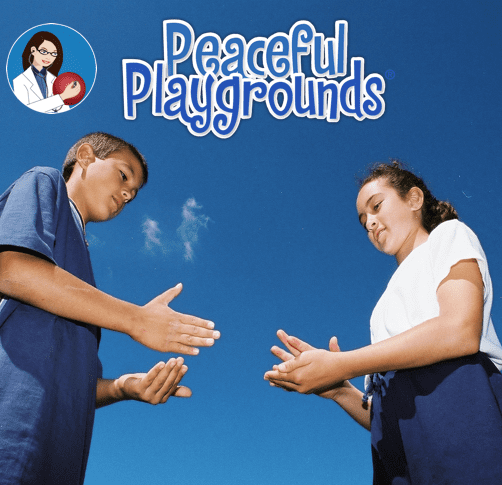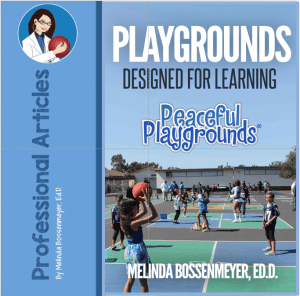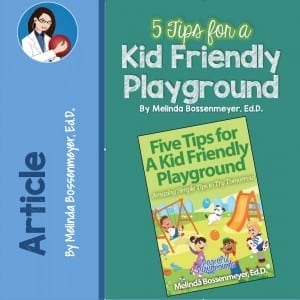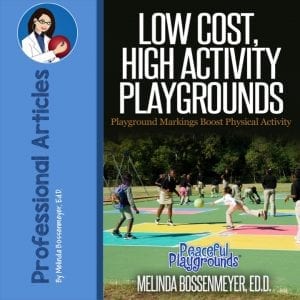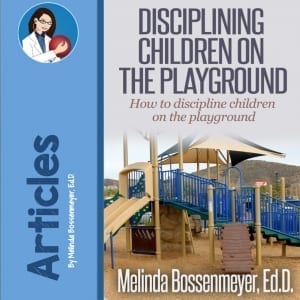School Playgrounds Can Be Safe
by Dr. Melinda Bossenmeyer, The Recess Doctor
School Safety Update – October 1998

New Program Improves Playground Safety
National School Safety Center
Pepperdine University – Malibu, CA
"As a playground supervisor, playground safety is of upmost importance. A playground supervisor at an elementary school for six years, stated that grade school playgrounds are not for the meek!" says Janis Dingwall, Cedarhurst Elementary School, Seattle. Each year over 200,000 children are injured on school playgrounds. That is 200,000 children sustain injuries serious enough to send them to the doctor or hospital.
In 1992, E. Hale Curran Elementary schools (K-5) in Murrieta, Calif., began its own study on playground safety. The school was three years old with a rapidly growing population. Its playground featured typical courts and games: hopscotch, tetherball, baseball diamonds, volleyball courts, slides, swings and climbing apparatus.
The Peaceful Playgrounds Program consists of five main components.
A blueprint for game markings – The first objective of the program is to disperse children evenly across the entire play area (black top and fields). Colorful carefully spaced marking that includes numbers, letters grids, and various geometric shapes delineate play areas. Not only are they attractive kids, they also give the playground a cheerful look of an amusement park.

1. A consistent Set of Rules
The second objective is to foster consistency and training for children and instructional aides. The rules for each game and piece of equipment are taught, posted and reviewed on a regular basis.
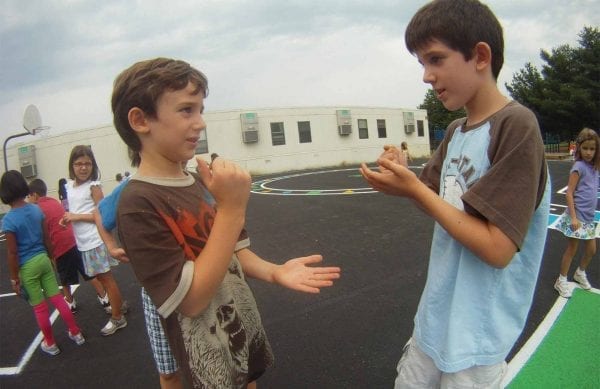
2. Conflict Resolution Strategy
Unlike the playground of the past where students were constantly wailing to the playground supervisor to settle disputes, these students come to conclusions by playing "Rock, Paper, Scissors." They know they have three options-ones that work well to solve disputes over rule infractions:
Walk away from the problem
Talk-together with the person with whom you disagree until an agreement is reached, or
Use "Rock, Paper, Scissors" game.
If the strife is the result of name-calling, teasing or hitting the youngsters involved are asked to leave their play area and are reminded that they must "work out" their disagreement before returning to the activity. Instruction in conflict resolution should outline three steps:
Determine who started the conflict.
Clarify the details of the incident.
End with an apology.
Resolution usually comes quickly because students are eager to get back to their games. Having children resolve their own problems free supervisors to do what they do best – look after the safety of all those on the playground.
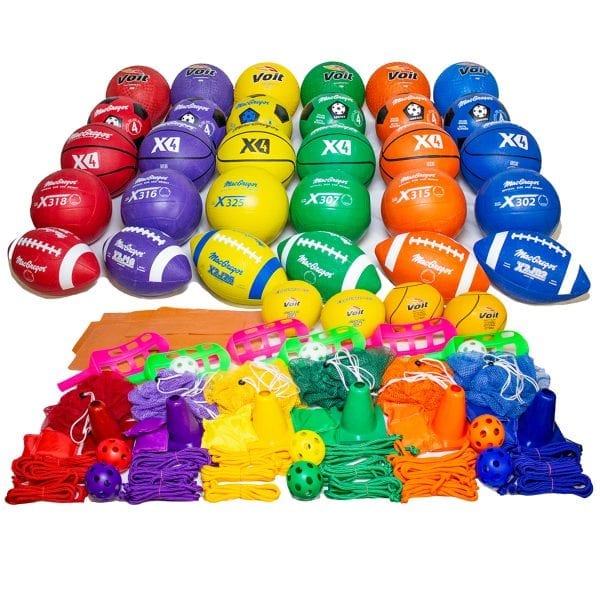
3. List of Equipment Required
Game area markings and rule mean nothing without ample and proper equipment. A detailed list of equipment necessary to supply the program through the 10-month school year is provided at the beginning of the year to allow for appropriate budgeting and purchasing.

4. Consistent expectations and training
It is especially important that the Peaceful Playgrounds Program be implemented school wide to ensure success. Each staff member must understand and support the program's objectives. Being able to play and work cooperatively empowers children and teaches them to work cooperatively in the classroom.
Peaceful Playgrounds Implementation Results in Injury Reduction
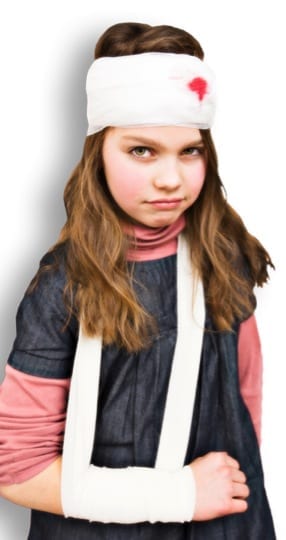
Injury Reduction Results
Melinda Bossenmeyer, the principal of E. Hale Curran Elementary School in 1994-95, put the Peaceful Playground Program into practice. She trained the entire staff, custom designed the grass and blacktop play areas, wrote rules and instructions, ordered equipment and supervised construction of the playground. By the end of the 1994-95 school year, the school's enrollment had risen to over 1,200 students, but total injuries had dropped by 50 percent. In 1996-97, the school population dropped since many of the students were moved to a new facility. By 1997-98, the school population had risen to almost equal the 1995-95 school year, yet the injuries were only 17 percent of the 1995-95 totals.
What contributed to such a dramatic decrease in injuries? Bossenmeyer attributes the decrease to three things.
Your Content Goes Here
What contributed to such a dramatic decrease in injuries? Bossenmeyer attributes the decrease to three things.
First
The game markings were laid out so children were distributed evenly across play areas. Since there were no congested areas, there was no unrest due to overcrowding.
Second
The students were instructed in the proper use of all equipment. For example, records showed that several injuries resulted from the inappropriate use of the monkey bars. Two basic rules made a difference: Hands must be the last thing to leave the bars, and nothing but the chin is ever above the bars.
Third
Improperly compacted sand falling-surfaces were replaced with wood chips layered to safe depth specifications.
"When kids go out on the playground, they know where they're going. They have favorite games, and they head right for them.
Ninety-five percent of the students are engaged in play, while the few others take time under the shade to eat their snacks."
Peaceful Playgrounds Distributes Students Across all Play Areas
Designed for K-6, the Peaceful Playgrounds Program distributes students evenly throughout the playing area and fields. With colorful markings and plenty of equipment, the objective is to engage the maximum number of students in healthy, often educational, purposeful play.
"The instructional aides who monitor the program have had lots of training, years of experience and know the importance of consistency," says Koltovich. "They have reached the point where they mostly move around the play areas watching high quality play at structured games."
"We make it look easy," says Geri McGuire, "but it takes time to train everyone (students, teachers, and aides). The instructional aides review the rules on a regular basis and then meet once a week to go over playground and classroom instructional practices."
Consistency in disciplining or helping children settle disagreements is aides' main objective
All the aides, including substitutes, wear aprons that hold hall passes, tissues, behavior referrals, bandages, reward tokens, pencils, a pair of rubber gloves and a rule book. Consistency in disciplining or helping children settle disagreements is the aides' main objective.
In order to foster healthy competition, aides plan tournaments at the various game sites. There are different games for different skill level and rules that allow for increased challenging levels of play.
Students have choices, but each choice has structure and limits. There are no limits to how many can play each game, but a child will go to a less preferred game rather than wait in a long line for a favorite.
The Dramatic Changes in Statistics Regarding Injury Reduction Proved to be an Unexpected Bonus
Across the nation, in River Vale, New Jersey, physical education teacher Ron Van Buren is using the Peaceful Playgrounds Program at Roberge School. From coast to coast, 8,000 schools are at various stages of implementing the program. It was created to promote peace, cooperation, and education. The dramatic changes in statistics regarding decreased injuries have proved to be an unexpected added bonus.
Dr. Melinda Bossenmeyer & Karen Robertson- Authors
Melinda Bossenmever, Ed.D., program manager for North County Professional Development Federation, is the author of Peaceful Playgrounds. Her web site address is www.peacefulplaygrounds.com. She is an expert witness in school injury and supervision cases. Karen Robertson, MS., instructional support coordinator for Murrieta Valley Unified School District, is the author of Raising Kids Right.
National School Safety Center
Pepperdine University
24255 Pacific Coast Highway
Malibu, CA 90263


